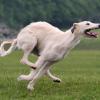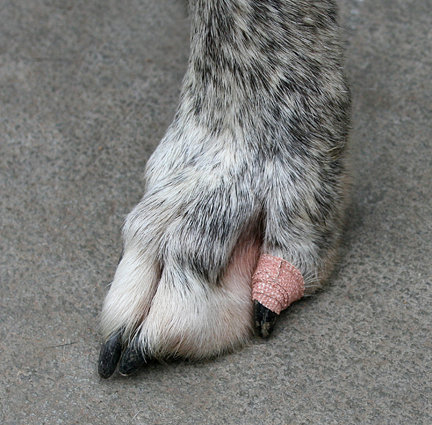-
Content Count
7,517 -
Joined
-
Last visited
-
Days Won
15
Content Type
Profiles
Forums
Gallery
Articles
Gun Dealer's and Fieldsports Shop's
Reloading Room
Blogs
Calendar
Store
Classifieds
Posts posted by skycat
-
-
Yes, absolutely do not try and bind nail beds that are even slightly inflamed or infected: it will be horribly painful for the dog and won't do any good. Wait until they are completely healed and not swollen at all before you do it. It's a pain cutting thin strips of Elastoplast fabric strapping, but I've found it's the best one to use.
-
 2
2
-
-
Some dogs just do get sore nail beds no matter how good their feet appear to be and how short you keep their claws. I used to have to bind the base of the claw on one of my coursing dogs, covering the nail bed and fixing the tape in place with a dab of superglue. It kept her running all season and at the end of the day I just washed the bits of tape off after a soak in hot salty water. The photo shows just one nail done: a bit of a faff but worth it to stop infection, soil, sand etc rubbing away under the nail bed. I got quite quick at it after a while and with the superglue to hold it in place they stayed on all day even in wet conditions.
-
 2
2
-
-
The habits you put in place, now, or are put in place by your other dog, will become ingrained for life. Quite apart from the physical dangers in allowing a very young pup to tear around after an adult: too much running too young can damage soft joints and bones. If you have to take both dogs out together then keep the pup on the lead while the collie tears around. Then swap them round. A 4 month old pup needs to learn that it cannot always follow the other dog in any case, so good training for it to learn to be restrained sometimes. And make sure to get the pup out just with you as well, as often as possible, or it won't listen to you and will be fixing its attention solely on the other dog.
-
 1
1
-
-
No, I think it was some Japanese island. Current thinking on how to feed dogs relates to their origins as much as the work load, which makes a lot of sense. Hence, Salukis do well on carbs as that's pretty much all they got: bread, dates, scraps. Dogs from rice producing countries can better make use of rice as part of their diet. Logically speaking, Collies, particularly hill collies from places like Scotland, survived more or less solely on porridge. No wonder they get fat so easily when fed a raw meat diet, something I've noticed particularly, just as I noticed that my Saluki lurchers lost weight badly when fed a meat/bone/offal diet and were coursing several times a week.
-
 2
2
-
-
You say your dog is fed on raw meat, but you don't say what else. Muscle meat alone is not a balanced diet. You need to think 'whole carcase', with a small percentage of bone, offal and roughage in the form of vegetables and maybe a slice of brown bread. To say that dogs need carbs depends a lot on the type of dog. I always found that my Saluki lurchers needed carbs to maintain good condition, whereas some Collie types do not, though if they're working regularly very hard it does help to keep them with enough meat on their bones. Fat is what most dogs use for energy, not carbs, though their genetic heritage plays a big part in how they process nutrients. I remember reading somewhere that dogs that had evolved on some island (sorry, can't remember details) were much better adapted to digesting fish than they were to mammal meat, and that dogs in Asia survived well on rice and scraps. We know so much more about canine nutrition these days, and nutrition in general that I can't understand anyone of average intelligence recommending that you feed a dog on something that is processed, mass produced and chock full of preservatives, additives etc. Personally, I want to see my dogs eating natural products rather than relying on some manufacturer telling me that my dog would do better on their product.
-
 6
6
-
-
We humans are such long lived things that the older you get the more dogs you'll lose: sad fact and one that becomes ever more poignant with age. Sorry to hear of your loss, Phil.
-
 4
4
-
-
I've also heard of Airedales bawling all day left alone. So much depends on the individual's temperament and how you manage them. It is a mistake to think that every example of a particular breed will behave or react in the same way and whilst certain breed traits do exist, the whole animal is affected by its breeding. For example, some lines of Salukis are noticeably more aggressive than others, although dog to dog aggression is something Salukis are known for particularly when it comes to guarding their catch. Some lines of Collie are hyper and neurotic, sensibly-bred lines are not, though generally they do need more stimulation and interaction with their owners than some other breeds.
-
22 minutes ago, Al92mc said:
A collie grey could definitely be a option! What are they like at home? Would be kennelled while am at work wouldn't want to be coming home to neighbors telling me my dog doesn't stop barking

How any dog behaves in a kennel depends on good genes and the pup being introduced to the kennel in the correct way: not just dumped there and left from day one and ignored. Dogs, being social animals, need company, and especially when they are young and feel more vulnerable. But getting a pup of sound temperament from sensible stock is the first thing. Then it is up to you to manage the pup's rearing and education so it doesn't see being kennelled as being abandoned where it feels it has to cry out for attention when your'e not there.
-
 3
3
-
-
Cracking dogs, but the second to last, the one where the little black imp is photobombing the pic: I laughed till I cried.

-
 2
2
-
 1
1
-
-
It must be difficult for you having to more or less start from scratch each time you go home, but not so hard as it is for the dog. If he gets zero exercise when you're not there he will never achieve full fitness. Each time he starts to get a little fitter then you have to go away again, so it's no wonder he's never the conditioned athlete you would like him to be. You don't say what breeding he is, but generally speaking, the larger and heavier the dog, the longer it takes to get it fit and the more quickly it loses condition when not being worked or exercised. Not only that, he must often be working with sore muscles, which doesn't help. Stamina is very far from being a simple thing to judge or analyse. The heart, for example, is a muscle that needs conditioning just the same as any other muscle in the body. The fitter the dog, the more efficiently the heart is able to pump blood, and therefore oxygen, around the body.
Also, hunting up, chasing, hunting up again: it is almost a form of training, known as interval training: fast for a bit, slower for a bit, and so on. It sounds as though he has plenty of want/drive, but the body can only do so much if it is not properly conditioned. Age, too, has a part to play, and a young dog recovers more quickly, gets fitter faster.
I'd expect most healthy lurchers of under 6 years of age, providing they are reasonably fit, to be able to hunt for several hours, but of course it also depends what they put up and what they are chasing, and how often they have to get into top gear and for how long. Lots of short runs on quarry that is either caught quickly or goes to ground is a lot different to long courses on stuff that just keeps running and running. Your question is not easy to answer given all the variables.
-
 2
2
-
-
Seldom has anyone written so succinctly or accurately about any type of dog. I would have loved to meet Dan Belkin. What a brain and an eye he must have had.
-
 2
2
-
-
I wish you the best of luck with them. Hopefully they'll make a full recovery. From what I read it seems to be a failure in development of part of the nervous system. Sounds as though you've made sensible decisions. Good luck.
-
 1
1
-
-
Interesting: I looked it up and watched a couple of videos after reading your post. I have seen the odd shiver in very young pups, but nothing remotely like true cases of shaking puppy syndrome. One thing I did read was that puppies grow out of it in 5-6 WEEKS, not months, as your vet said: but, that's only what I've read so one can't believe everything on the internet, eh! I'd do a bit more research, try and speak to a specialist neurologist to get a better prognosis. I can't see that a pup that wobbles and shakes really badly would thrive if it was bashing itself around until 6 months old.
-
 2
2
-
-
Lots of positive advice on here, but the fact remains that if you don't have time for the dog and it's not getting the exercise or attention it needs, the problem will only get worse. It's not fair on the dog or your wife if it's causing tension in the household. It's all very well saying stick with the dog, but if neither of you have enough time or energy to give the dog what it needs, I really think it would be best to find it another home. BUT please don't just give it away to anyone. There's plenty of people who'll say yes, they'll have it, and further on down the line you may find they've neglected it, left it stuck in a kennel, done nothing with it, or sold it on again. This happens all the time. People are full of good intentions and then change their minds, or their own lives may take a more complicated turn for the worse. If you do decide to rehome the dog then get in touch with Lurcherlink, who really do understand lurchers and their needs and thoroughly vet potential owners.
-
 4
4
-
 2
2
-
-
I have sent you a pm. Please go to your messages inbox.
-
That's a great little bushing dog in the making ... but mine is supposed to be a lurcher

-
 1
1
-
-
9 hours ago, bird said:
is your Airedale red line somthing like that , a USA line bred dog, i think there proper line bred for bear, wolf , they use couple in a hound pack to strengthen it up , they way it read .!
Yes, that type of Airedale is known as a Redline. Often much smoother coated and boxier in shape than the other American types of Airedale. Very multi-talented dogs, as at home retrieving feather as they are at treeing large game. If I'd been younger I'd have imported a dog to go over Dill. Sadly she died at 8 years old from cancer, and my heart wasn't really in it as there didn't seem to be much interest in working Airedales in the UK. They're better off over the pond where at least they can be used on a variety of larger game. I wouldn't say they're that popular over there either: it is hard to introduce a new type of dog to people who are set in their ways: think scent hounds for hunting large game, or, over here, Labs and Spaniels in the shooting field.
-
1 hour ago, bird said:
how did the Airedale x grey go penny ? , and think you said before the Airedale you use , are better than the show stuff we got here, are they a USA line something like that ?
The Airedale lurchers aren't actually Airedale cross Greyhound as their sire was a generations bred coursing dog, but mostly Saluki, which accounts for why they are much more finely built than a straight Airedale/Grey cross. I have been very happy with them overall: superb noses and hunting ability. Both retrieve and take all quarry, so long as they can catch it: they're hardly the fastest things on four legs, but their strike and commitment more than make up for a lack of speed. As general mooching, hunting and lamping dogs they are great, and go through all cover like a knife through butter.
-
 2
2
-
-
That's a stunning animal, Bill. Head like a bear.
I shall never know exactly what's in my pup though the breeder did say there was no bull or Saluki. It's just fun trying to recognise various traits in her, and yes, she has got a very short, thick neck. I'll put up more photos as she matures.
-
Yes, she's certainly got the herding mentality: thankfully she's also very willing to take instruction or she'd be a right little madam given half a chance.
-
3 hours ago, ginger beard said:
And it sounds like it has the wheaten in his too.
Not had anything to do with wheaten types though I guess that stoical and feisty would be part of their make up?
-
4 hours ago, Allan P said:
Definitely some of Mr Burrels Tumbler/Norfolk in there somewhere.

-
39 minutes ago, W. Katchum said:
I like it, reminds me of donkey the 3/4grey 1/4 deerhound we had that ended up 33ats an well over 100lb




Gee thanks: just what I needed to hear!
-
Thanks Bird. Actually I was thinking of calling her Stumpy, cos her legs seem so short, but even at such a young age she has a surprising amount of 'blast off' speed: won't be long before she's catching the Airedale lurchers ... mind you, they're not exactly what you'd call fast.
 Also she's very focused and intent already. A very interesting pup indeed, and mouthy as hell with that sort of disdainful stare when she thinks you're not worthy. I'm having to up my game considerably in the training stakes: making things more fun than ever before.
Also she's very focused and intent already. A very interesting pup indeed, and mouthy as hell with that sort of disdainful stare when she thinks you're not worthy. I'm having to up my game considerably in the training stakes: making things more fun than ever before.




retching/gulping
in Working Dog Health & Training Talk
Posted
I'd be getting x rays and CT scan if you can afford it, or maybe a look down her gullet with a camera? Sounds more than acid reflux to me.